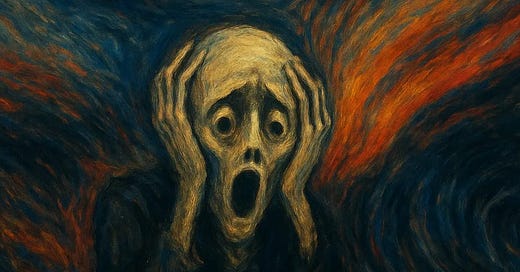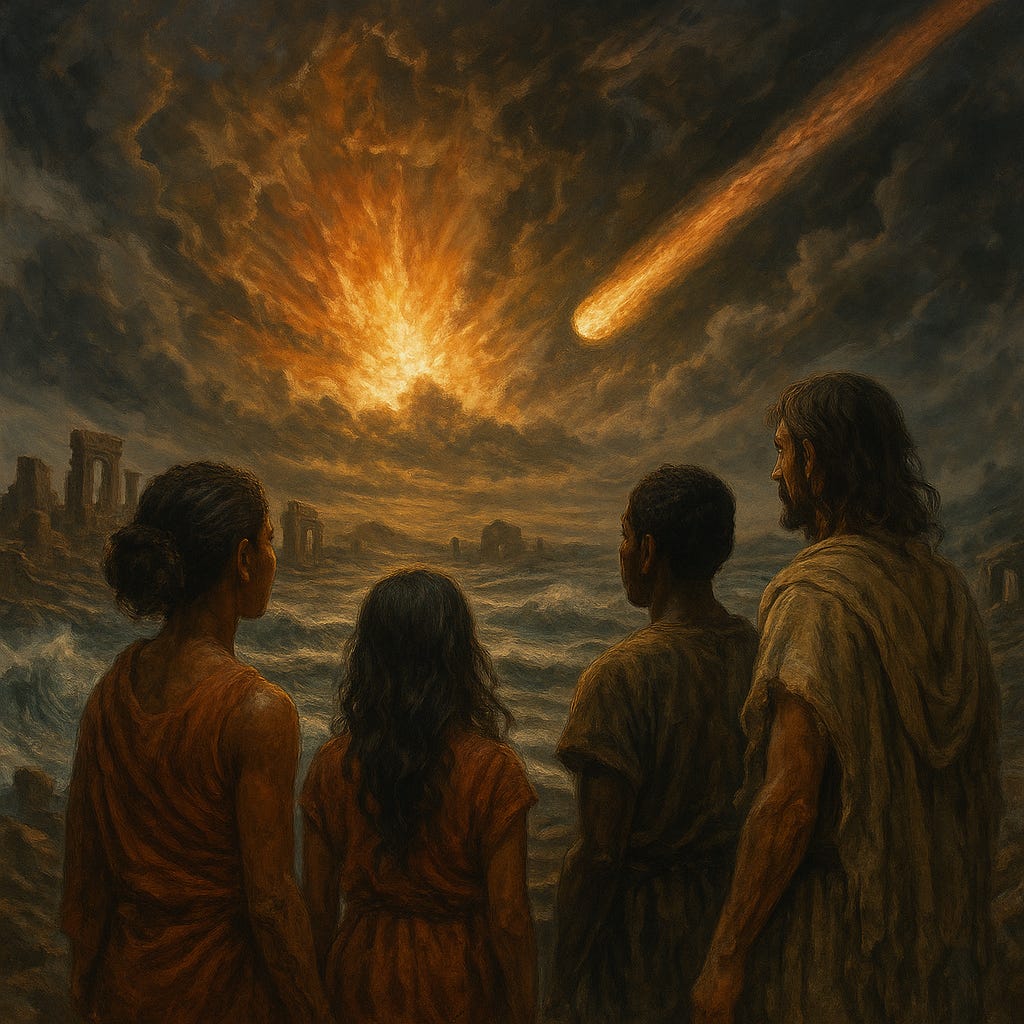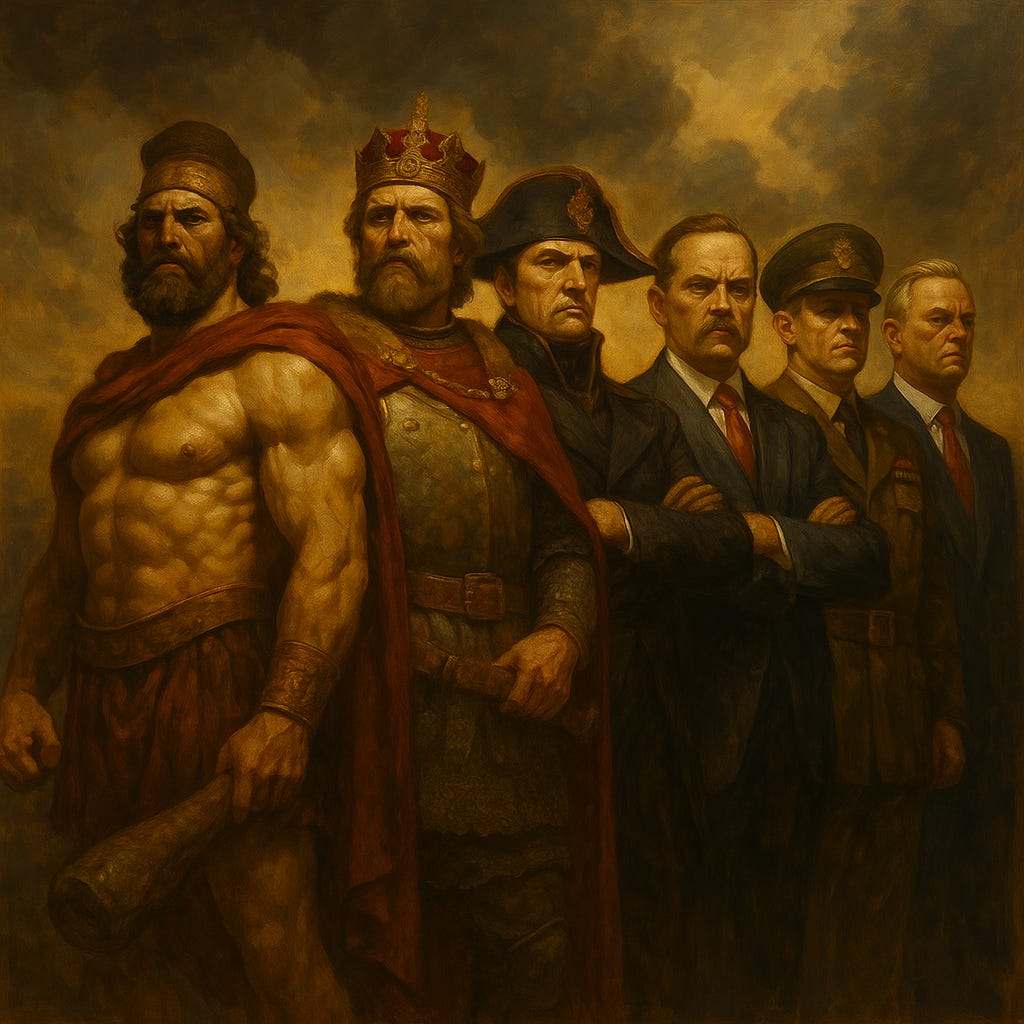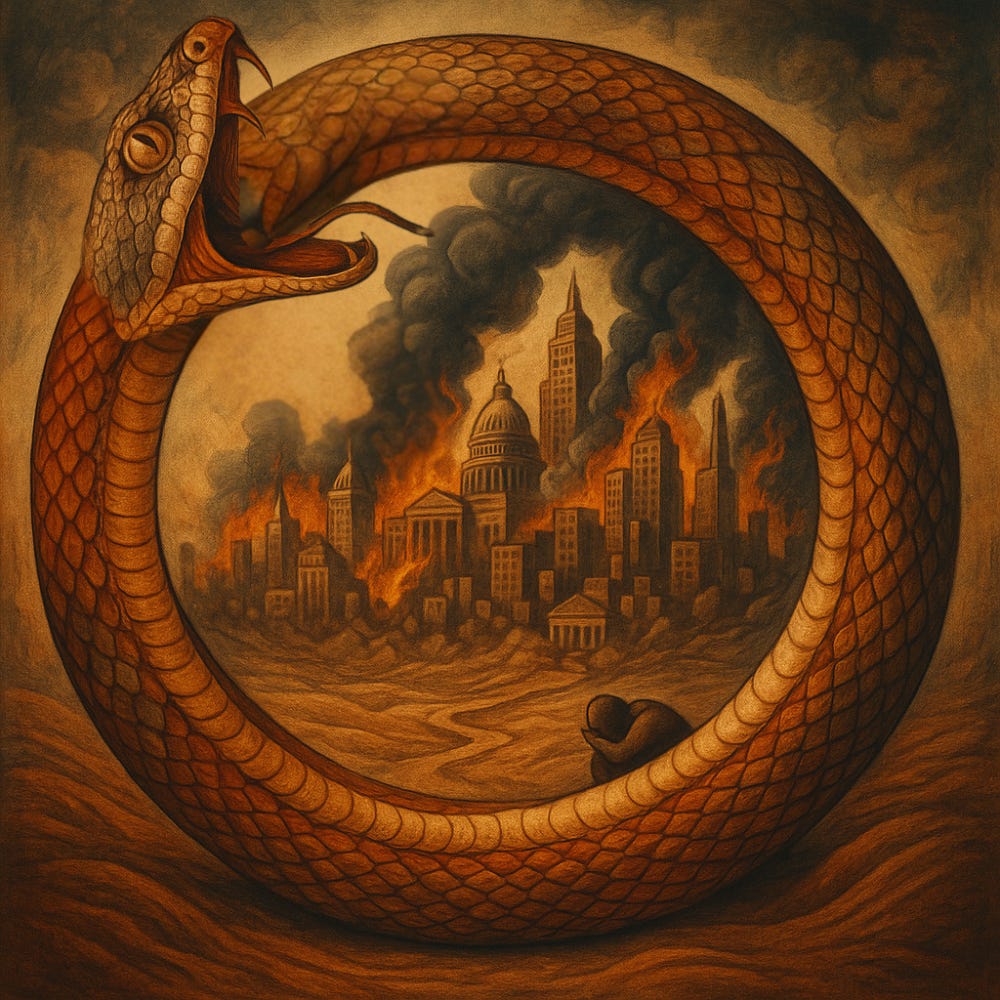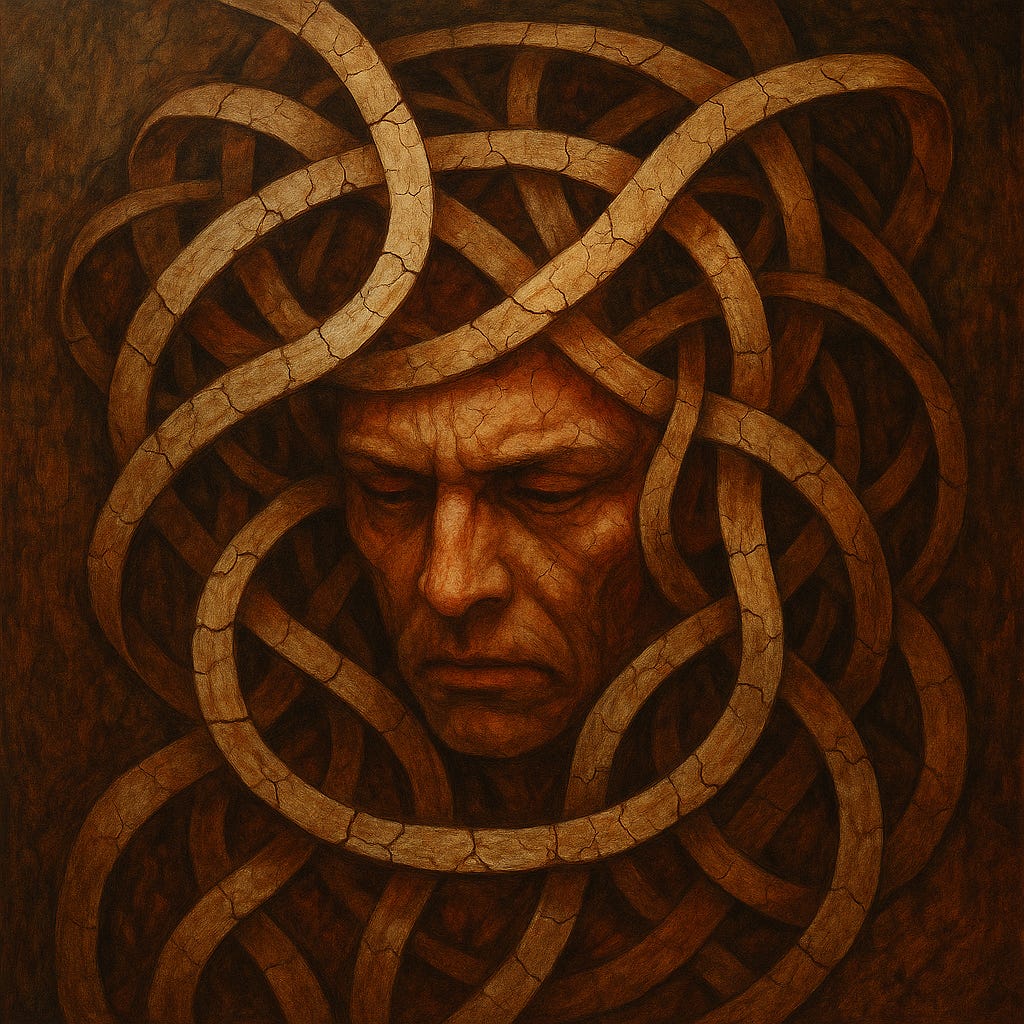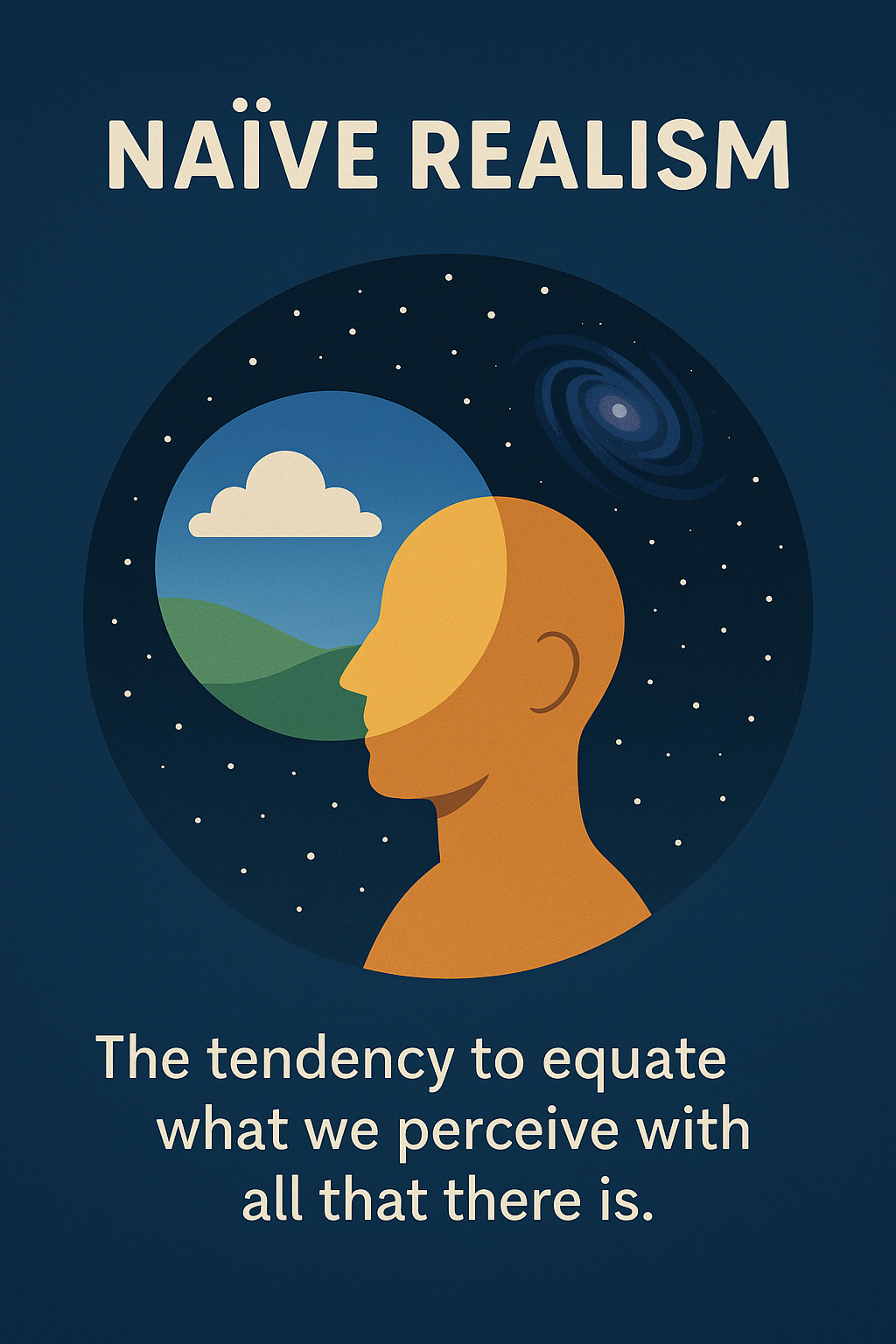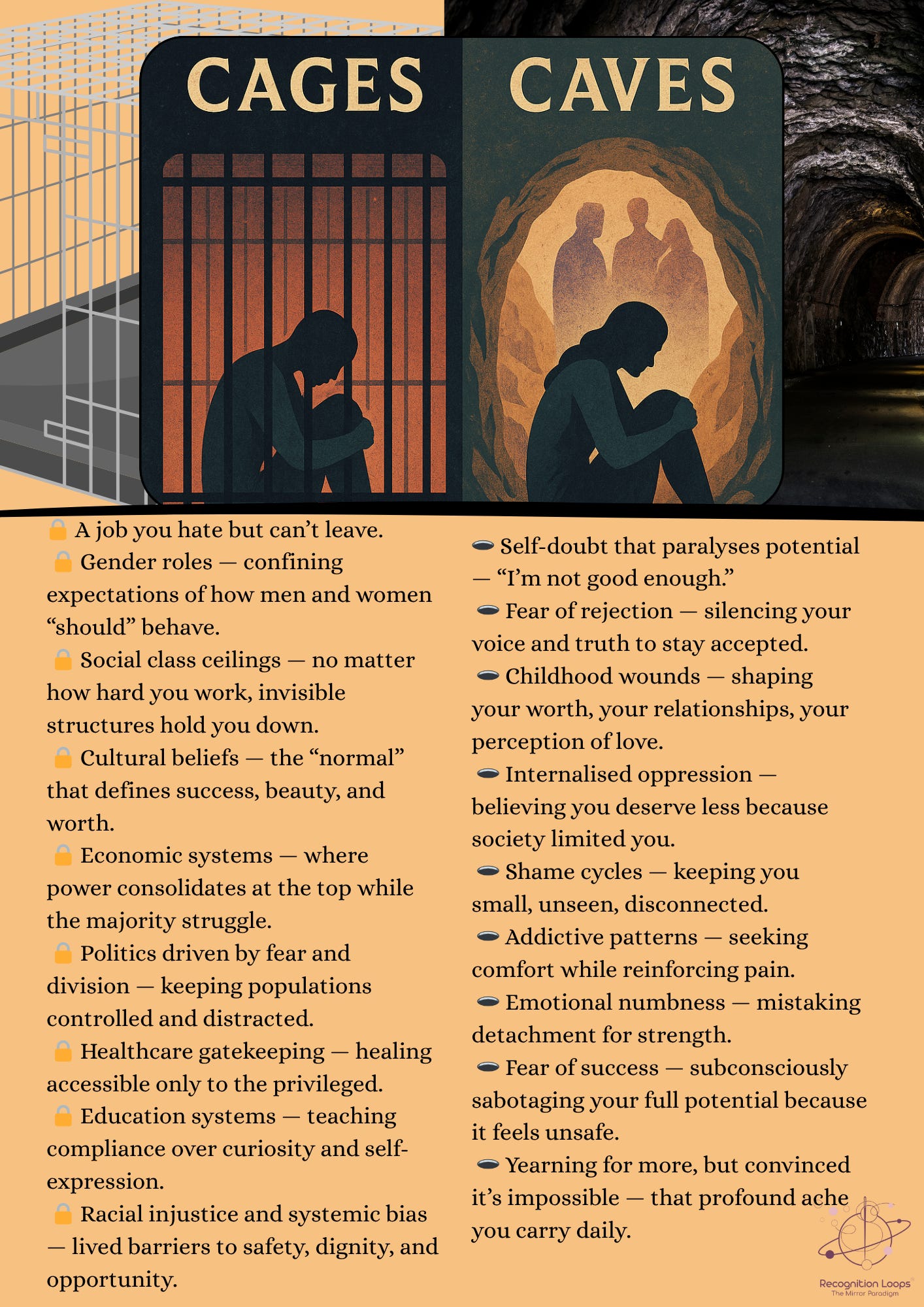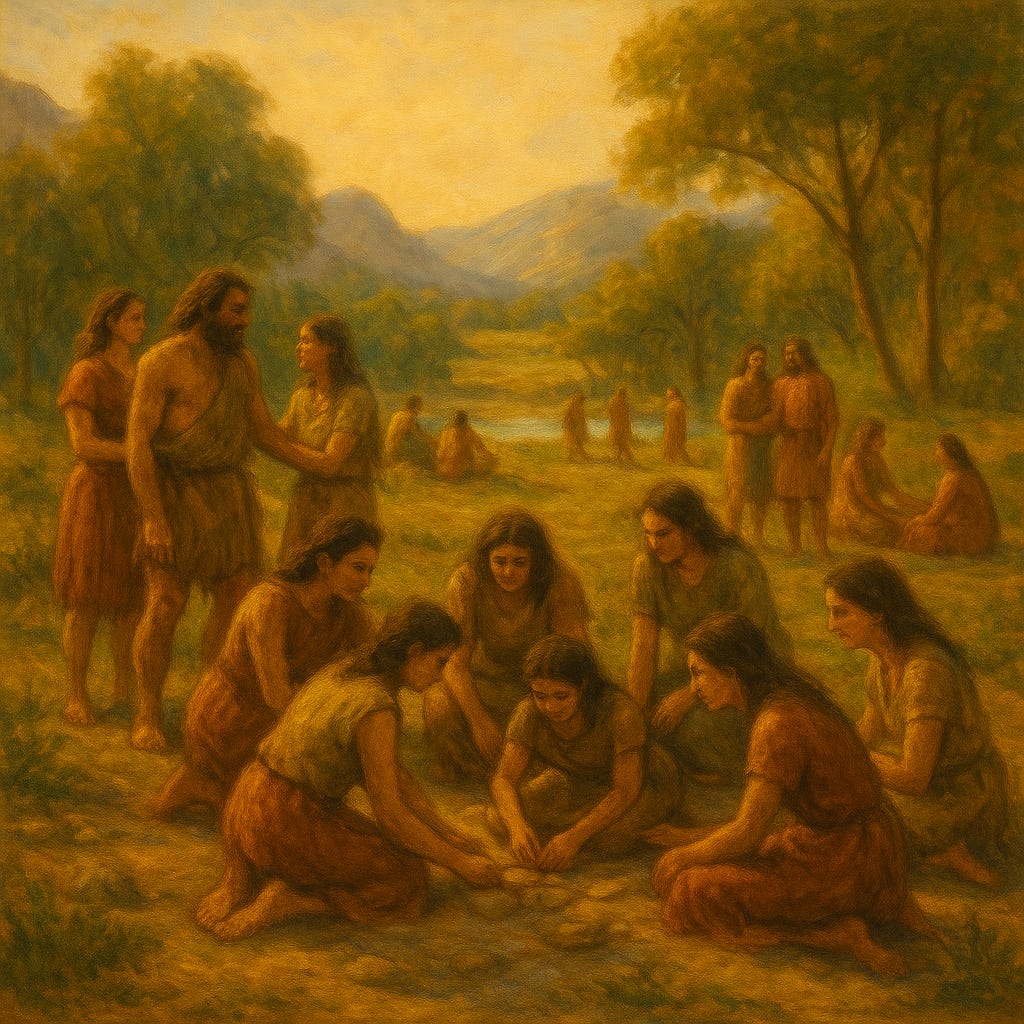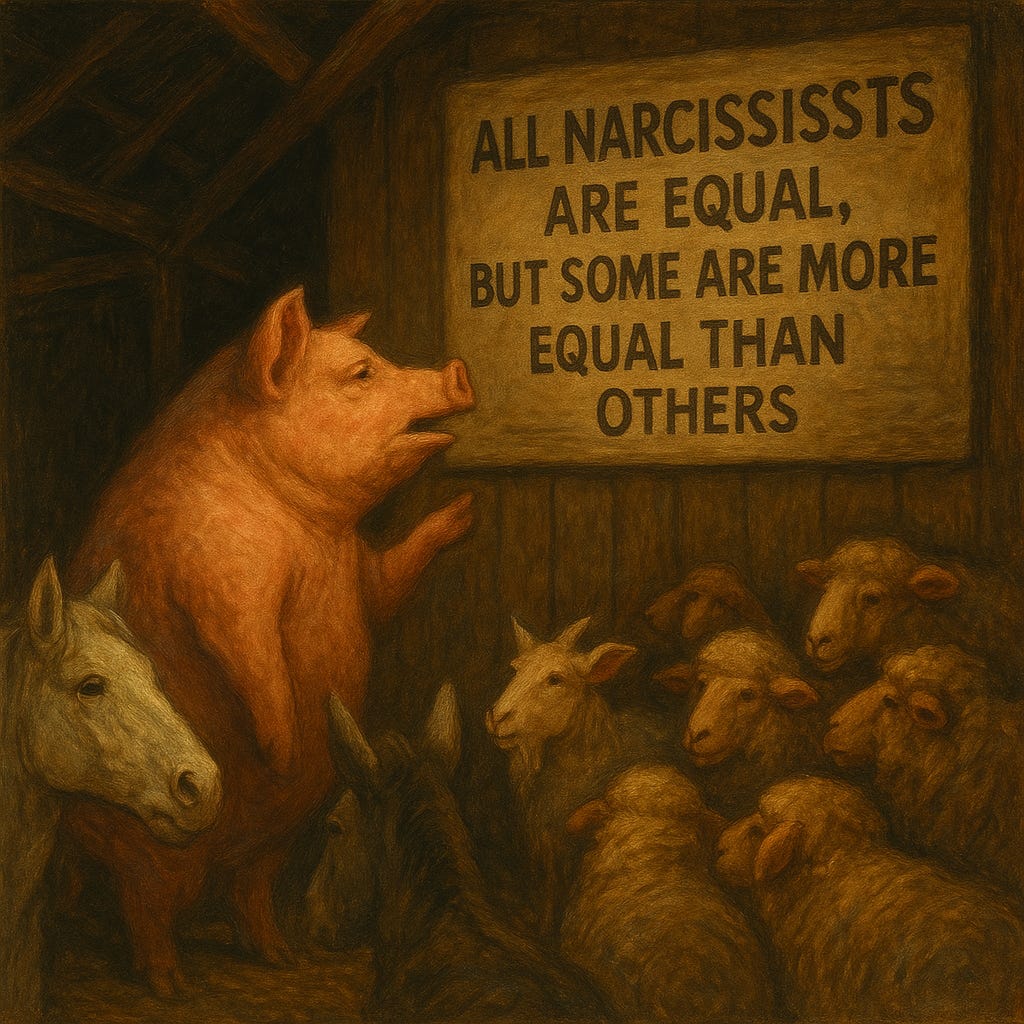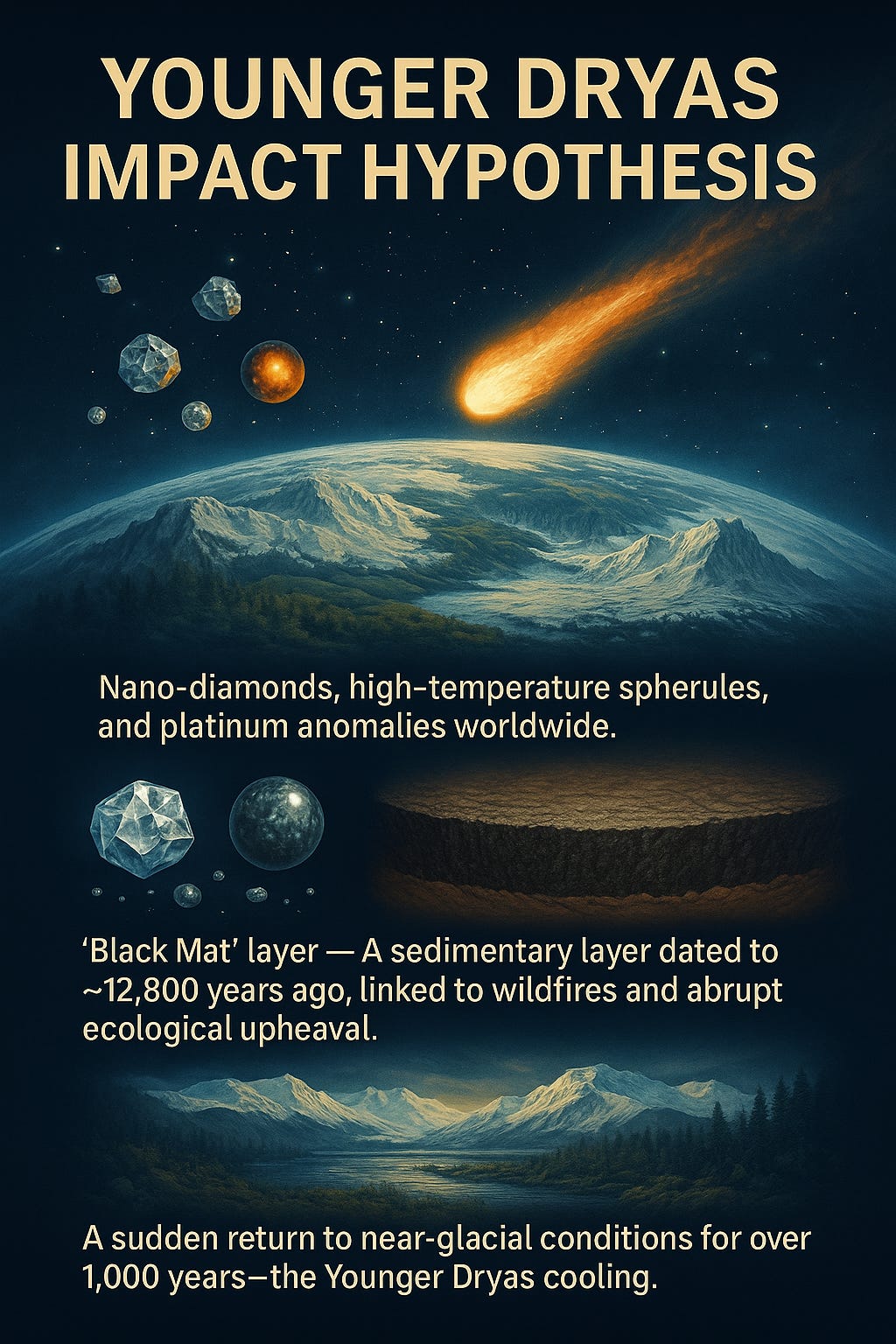Origins of Patriarchy Part Two
The Beginning of the End: Humanity's 12,000 Year Collapse
UK Male Narration:
When the Sky Fell: The Forgotten Cataclysm That Rewired Humanity
Many believe human civilisation was built on power, dominance, leadership, and the natural superiority of patriarchy—and the archetypally masculine traits it exalts.
But what if we’ve been admiring nothing but leftover ruins?
The Natural Order? Recognising Our Humanity
What if our empires, our systems, and our achievements aren’t reflections of brilliance or supremacy but the meagre offerings of a debilitated species doing its best while trapped in an endless trauma loop?
What if our magnificent architecture, inventions, technology, and science—the things we hold up as the pinnacle of human progress—are instead the scorched remnants of a world that never truly became?
Every time we search for our reflection in the world, all we find is a cracked, distorted mirror—shattered by wounds we’ve forgotten.
Patriarchy did not emerge because men were inherently better leaders, physically stronger, less emotional, or naturally more competitive and dominant.
It arose due to a significant disruption in the world, and we’ve been in a tailspin ever since.
What if humanity hadn’t endured misery, power imbalance, hardship, and fragmentation for millennia… and all that energy consumed by fear and survival had been freed to nourish our souls?
What if every ounce of human endeavour had been directed toward liberating the full spectrum of our potential, creativity, and consciousness?
What world might we have built?
What might humanity have become?
And who might you have been in such a world?
Around 12,000 years ago, the world fractured 🌍💔
A global rupture—hidden beneath myths and forgotten histories—rewired human civilisation, twisted our biological and cultural evolution and trapped us in a looping cycle of trauma we’ve called progress ever since.
Part Two of The Origins of Patriarchy explores how that rupture reshaped everything. How trauma responses became systems, systems became culture, and culture became “reality.”
But if trauma created the human world, recognition can rebuild it.
👇🏽 If you missed the beginning of this story—the forgotten roots of humanity and how the Mirror Paradigm reframes our origins—please start with:
Here’s what this article will explore:
🔴 How catastrophe hardwired patriarchal systems into our culture.
⚔️ How trauma fuelled cycles of fear and scarcity have echoed for millennia.
🗝️ And how recognising the pattern might finally set us free.
In Part Two, we’ll untangle the story you were never told:
✅The Traditional View: The Myth of Progress — How the belief in linear evolution distorts our understanding of human history.
🔍 The Mirror Paradigm Interpretation: Reality Does Not Progress Linearly—It Repeats in Cycles — A world lost to catastrophe and a species reshaped by trauma.
🔬The Science Bit: Hard Evidence for a Global Cataclysm & Forgotten Balance — Here, we explore the evidence hidden beneath floods, buried in ice, and encoded in forgotten ruins and ancient knowledge.
🧭What It Means For You: Our Entangled Loops— we'll consider what the Cataclysmic Patriarchy Hypothesis (CPH) means for you in the final section — and explore how your life still echoes that ancient collapse—and how recognition is the secret key to unlocking it and breaking the cycle.
Are you ready to recognise what’s hidden in the shadows?🗝️
✅The Traditional View
UK Male Narration:
The Myth of Progress
For decades, mainstream historical and anthropological narratives have framed the emergence of patriarchy as an inevitable outcome of human development.
We are led to believe that patriarchy is a product of biological differences, competition for resources, and the demands of increasingly complex societies that require archetypal masculine traits to maintain themselves and sustain order.
It is a narrative that appears logical on the surface, reinforced by education systems, political structures, and long-standing academic frameworks.
It is important to note, however, that not all scholars agree with this interpretation, and alternative perspectives continue to gain traction.
The traditional view rests on a foundation of assumptions, generalisations, and selective interpretations of historical evidence.

Linear Progress as Human Destiny
A dominant assumption in conventional history is that human development follows a linear, upward trajectory:
🦴 Early humans survived through physical strength and instinct.
🌾 The agricultural revolution led to the development of settled societies and technological innovations.
🏛️ Hierarchies and governing structures arose to organise these societies.
👑 Patriarchy, dominance, and competition emerged as natural extensions of this growth.
⚙️ Technological advancement is equated with social evolution.
In this framework, patriarchy is seen as both inevitable and necessary—an unquestioned byproduct of civilisation's progress.

“Survival of the Fittest” & Masculine Dominance
Within evolutionary psychology and early anthropology, it is often claimed that patriarchy developed because men were physically stronger, more aggressive, and inherently better suited for leadership.
The argument asserts:
🛡️ Male dominance enhanced group survival.
🥩 Competition for resources and status favoured male leadership.
🏆 Hierarchical structures represent evolutionary success and masculine biological supremacy.
While widely circulated, this interpretation has been extensively critiqued for oversimplifying human behaviour and ignoring the role of cooperation in early human history.
Studies of forager societies, including the Kung San and Hadza*, reveal the centrality of sharing and collective decision-making, challenging simplistic notions of the inevitability of masculine trait dominance.
*Refer to “Sources” for further info
Read the article that challenges the “survival of the fittest” myth here 👇🏽
Biological Determinism & Gender Roles
Closely related is the argument of biological determinism—the belief that gender roles are rigid and biologically predetermined:
🏹 Men are naturally inclined to be hunters, protectors, and providers.
🍼 Women are inherently caregivers and dependents.
💥 Traits such as emotional insensitivity, aggression, and competitiveness are coded as masculine.
💫 Intuitive intelligence, cooperation, and emotional sensitivity are feminised and undervalued.
This view frames patriarchy as the inevitable social expression of biological realities rather than a cultural construct or any other possible explanation.
Patriarchy as a Requirement for Civilisation
Another prevailing belief is that male-dominated hierarchies were required to sustain complex, large-scale societies:
🏛️ Hierarchical leadership ensures order and stability.
🛡️ Control mechanisms prevent societal collapse.
👨⚖️ Masculine-coded authority is assumed to bring structure to what would otherwise be chaotic, disordered human groups.
That idea still shapes how we see leadership, power, and society, framing patriarchy as the backbone of civilisation.
But more than ever, people are questioning whether that story holds up.
And the cracks in the system are starting to split wide open.
Competition as a Universal Human Trait
Beyond gender, competition is framed as a fundamental aspect of nature:
🧬Competitive behaviour drives evolution and innovation.
👑 Hierarchies and dominance are inevitable outcomes of competition.
🌈 Cooperation and egalitarian models are dismissed as unrealistic, utopian, or idealistic.
This perspective embeds patriarchy within a broader, survivalist interpretation of human social behaviour and natural biology.
Technological & Military Superiority as Evidence of Success
For centuries, we’ve been told that technological and military dominance equals civilisational success:
🌾 The rise of agriculture, engineering, and organised warfare is framed as humanity’s great leap forward.
👑 Patriarchal, hierarchical structures are praised as the engines that made it all possible.
🌍 Societies that conquered, expanded, and dominated others are cast as evolutionary victors.
However, the uncomfortable truth is that this story perpetuates a cycle of endless, futile, ultimately destructive conflict.
The idea that power, conquest, and technological control are the hallmarks of progress keeps humanity locked in the same horrific patterns—war, inequality, and environmental collapse.
We’ve been sold a story of glory and unstoppable progress.
But history reads more like a brutal parade of empires rising and collapsing, each leaving more devastation in their wake,
as human distortion and technology evolve exponentially faster than our wisdom.
Increasingly, scholars, activists, and thinkers are questioning the traditional narrative.
They argue that innovation, stability, and technological advancement can—and still do—emerge through cooperation, relational intelligence, and egalitarian models rather than through dominance and control.
If the only measure of success is who builds the biggest weapons, claims the most land, or owns the most resources, we shouldn’t be surprised that peace feels impossible.
The Marginalisation of Alternative Social Models
Perhaps the most significant oversight of mainstream opinion is its exclusion of evidence for alternative social structures:
🏺 Archaeological findings suggest egalitarian, cooperative, and potentially matriarchal societies once existed.
🌿 Sites like Çatalhöyük, Skara Brae, and Old European cultures challenge assumptions of universal patriarchy.
🗣️ Indigenous knowledge systems and oral traditions are dismissed as myths rather than considered historical data.
🕳️ Anomalies in the archaeological record that contradict the linear progress model are often marginalised or labelled pseudoscience.
These omissions create a distorted historical lens that presents patriarchy as inevitable and alternatives as fringe speculation.
Why People Cling to the Old Story — and Mock the New
We like to believe that outdated beliefs fade with time and that a more precise or eloquent truth gradually emerges.
In reality, most people cling to established systems, defend them, and often mock, dismiss, or actively discredit anything that deviates from the norm.
It goes beyond stubbornness or self-righteousness—it’s a deeply ingrained fear response in human psychology.
This survival psychology shapes how we behave collectively when acquiring power or status.
In a shared perceptual reality of scarcity and hostility, we adopt rigid strategies and desperate compromises to survive.
Ego, fear, and power hoarding keep this machinery running.
As studies like the Stanford Prison Experiment* reveal, once we hold power or status within an unequal system, we feel compelled to maintain our authority and rarely relinquish it.
Especially when that system is built on scarcity, control, and fear—a system where everyone, whether they realise it or not, is driven to hoard, compete, and dominate, convinced it’s the only way to live.
*Refer to “Sources” for further info
The Hidden Engine of Imbalance: Distorted Sensitivity
It’s not just the external structures and established systems resisting change — it’s embedded in how we perceive reality.
We are all, individually and collectively, hyper-masculinised — not in terms of gender, but in terms of distorted perceptual fields and relational dynamics.
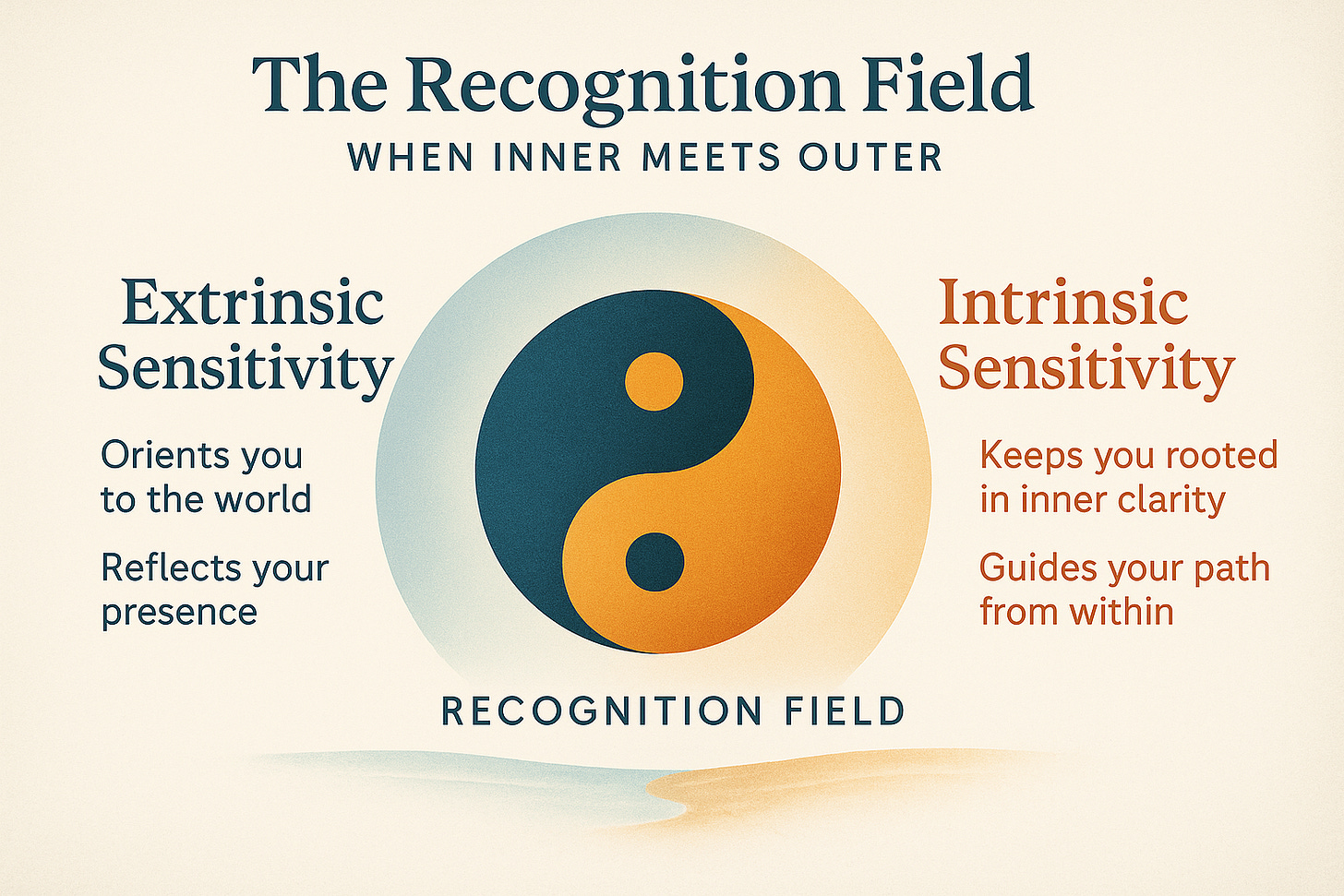
Our Extrinsic Sensitivity (ES)— Our ability to spot patterns, threats, opportunities, and all structures in the external world — has been amplified to an extreme.
Our Intrinsic Sensitivity (IS) —The ability to recognise patterns, needs, and misalignments within ourselves — has been suppressed, dismissed, or forgotten.
The imbalance is the inevitable consequence of living in a system that rewards external dominance, control, and validation while systematically suppressing innermost needs, emotions, intuition, relational intelligence, and self-coherence.

Read the article about human distortion and imbalance here 👇🏽
☯️ Intrinsic & Extrinsic Sensitivity: The Recognition Field Matrix
🌊 The Hidden Thread You’ve Always Felt
What is the Result?
A world trapped in endless Distorted Recognition Loops—recycling imbalanced patterns of power, collapse, fear, and survival.
A trauma loop masquerading as progress.
The snake that eats itself.
A system incapable of allowing true novelty to emerge—because genuine change threatens the structures, hierarchies, and illusions of control it depends on.
Real novelty—not the regurgitation of repeated cycles in different forms—requires inward focus.
It arises from inner sensitivity: awareness of our unique patterns within.
A hyper-masculine system recoils from emotional sensitivity as ferociously as it fears its destruction.
And so we loop. And collapse.
And call it progress.
Our external world reflects the imbalance within — a world that feels like it’s fracturing, disintegrating, hanging on by a thread — because, in a profoundly “real” sense, it is.
If the world outside is only a reflection — a distorted echo of the patterns within — then the only way to break the loop is to see the mirror for what it is.
And to recognise our hidden reflections, staring back in plain sight.
This is where the Mirror Paradigm begins.
Read the article about human trauma and abuse cycles here 👇🏽
Deconstructing the Traditional View
Mainstream views depict patriarchy as the logical outcome of biology, survival pressures, and linear societal evolution.
Yet beneath this narrative lies a framework built on selective interpretations, untested assumptions, and overlooked evidence.
If we consider patriarchy not as a predetermined feature of human society but as a response to collective trauma and environmental rupture, a different picture emerges...
…A story that is reflected everywhere, across all scales of human experience, from the private sanctums of our minds and close relationships to the global structures and systems of society and culture.
What if the hierarchies, dominance structures, and fragmentation that define modern civilisation are not signs of advancement but symptoms of a species caught in a never-ending, looping nightmare?
🔍The Mirror Paradigm Interpretation
Reality Does Not Progress Linearly—It Repeats in Cycles
UK Male Narration:
You were not meant to sleepwalk through life, but something is keeping you sedated. Dazed and confused. Enduring a living nightmare.
Mainstream historical narratives depict human civilisation as a story of linear progress: an ever-ascending path toward greater knowledge, power, and control over ourselves and the environment…The most supreme beings ever to exist on planet Earth.
But on whose authority do we lay this claim?
By what criteria?And is it even true?
At first glance, the story appears to hold up.
We are brilliant at mastering ourselves and our environment. No other species has extracted, controlled, and transformed the natural world at this scale.
What we’ve learned about medicine, disease, biology, ecosystems, the cosmos, and ourselves is nothing short of miraculous.
But here’s the catch:
We perceive only what we already know how to recognise.
We live within a closed perceptual frame — fragments of the vast, dynamic relationship between ourselves and the world that we’ve managed to decipher.
Within that limited scope, our achievements might appear impressive, but they are only remarkable to us, restricted by the limits of our understanding.
Picture the ant, surveying its intricate nest with smug satisfaction: perfectly straight tunnels, astonishing efficiency, and flawless organisation.
Yet it remains entirely oblivious to the towering skyscrapers, rockets, satellites, and global networks that surround its tiny world.
This reflects a profound psychological tendency in humans as well: naïve realism — the belief that what we currently perceive and know represents the entirety of reality.
We instinctively assume that our perceptual range is complete.
In truth, what we experience is only a sliver of reality.
This illusion of completeness leaves us unaware of the vastness of what lies beyond the limits of our current understanding.
The Dunning-Kruger effect exacerbates this trap—a cognitive bias in which limited knowledge leads to overconfidence, effectively masking our ignorance.
Every era is convinced of its superiority—its progress, mastery, and pinnacle of sophistication.
But this certainty conceals the enormity of everything that remains unrecognised and unmet—the needs starving in plain sight, yet felt with full force.
We confuse what we have created with all that exists, and build our world on this tragic, self-fulfilling illusion.
Human reality is so broken and distorted that, to shield ourselves from the misery of our reflection, we retreat into comforting narratives of glory—remaining ignorant to the darkness quietly consuming us.
Wrapped in the comfort of ignorance and the illusion of greatness… we yield to the shadows—the ever-tightening grip of our collapsing potential.

These perceptual limitations ripple outward, becoming the architecture of civilisation.
When our inner patterns distort, so too do the systems and stories we construct to contain them.
And when those patterns are shaped by fear, fracture, and distortions, the future unfolds in loops.
Not forward into opportunity, but backwards into darkness.
🌍 Global Loops: Distortion at Civilisational Scale
We face planetary crises—climate change, ecological collapse, inequality—but instead of novel responses, our solutions loop back into familiar structures: economic growth, corporate control, and political negotiations shaped by entrenched interests. Even many “green initiatives” are driven by short-term profit and power, not by radical relational repair with nature. We externalise responsibility to systems, failing to recognise that the real work begins with realigning our relationship with Earth as a living whole.❤️ Personal Loops: Distortion in Intimate Relationships
In close relationships, we often perform outward harmony—saying what’s polite, repressing difficult emotions, hiding vulnerability—because we are taught from childhood that love depends on approval. But beneath that performance, unmet needs and unspoken truths accumulate. We externalise connection while losing its essence, then wonder why our relationships loop into conflict, withdrawal, and collapse.⚖️ Across All Scales: Culture, Work, and Education
In education and workplaces—domains that could nourish originality—we’re conditioned to conform: obey rules, repeat accepted knowledge, fit in. From an early age, we’re praised for adapting, not for originality; for aligning, not questioning. We learn that standing out is risky and that novelty threatens the status quo. So, rather than generating innovation from our unique inner sense, we replicate accepted patterns, producing incremental tweaks disguised as progress.
If a world beyond your perceptual horizon never comes into focus, it simply never becomes part of your reality.
Contrary to intuition and conventional belief, history doesn’t move in a straight line.
It flows in cyclical waves — recursive, fractal loops of coherence, trauma, collapse, and adaptation —where the same dysfunctional patterns resurface across all scales.
Humanity has endured millennia of trauma, fragmentation, and collapse, cleverly disguised as progress, and tragically mistaken for evolution.
We are chained within societal cages, hiding in pseudo-comforting caves of illusion.
Everyone strains to escape, longs for liberation, and hopes to experience themselves in the best possible light…
All while mistaking echoes for answers,
pain as inevitable,
and shadows for truth.
Civilisations rise, then fall.
Societies expand, then fracture.
The human world loops sideways—cycling through the same dysfunctions dressed in new disguises.
Technological innovation. Economic growth. Political revolution.
Yet, everything rests on the same unstable foundations.
Far from progress. This is recursion.
Beneath these loops lies a different way of being—a way that once defined us, and could again:
🌿 Sophisticated relational intelligence — sensing and attuning to one another with nuance and care
⚖️ Egalitarian balance — systems of fairness, reciprocity, shared power
🤝 Deep cooperative interdependence — relationships that strengthen the whole
🧩 Genuine conflict resolution — resolving tensions through creativity and collaboration, not dominance and control
This way of being is encoded within us — in our biology, our ancestry, and our deepest yearning for something more.
But one vital part of us has gone dormant, hidden away, waiting for the storm of deprivation and hostility to pass.
Our potential was buried beneath fear.
Lost in rupture. Distorted until distortion became the only reality we could recognise.
Recognition is the key — the missing link that will recalibrate human reality.
What unlocks this shift?
Remembering what was forgotten.
Allowing transformative novelty to unfold through you.
Integrating with the wisdom already alive within you.
🌱 Before the Collapse — A Different Human Story
Before stratified empires and patriarchal systems, human societies were not utopias, but they were relational, cooperative, and balanced, not ruled by dominance and hierarchy.
Environmental stresses came and went. Famine, migration, conflict. But these were ripples, not tsunamis; temporary fractures, not entrenched hyper-masculinisation.
🪶 The Relational World of Our Ancient Ancestors
Across continents, humans lived in egalitarian, relational systems—many of which were female-centred—prioritising care, cooperation, adaptability, and social balance.
Faint echoes of this lost way of living still ripple through the natural world and human memory:
🦍 Bonobo social structures — built on cooperation, female alliances, and conflict resolution through connection.
🐘 Matriarchal elephant herds — guided by the wisdom and memory of elder females, ensuring survival through relational intelligence.
🐬 Cetacean cooperative systems — whales and dolphins navigating vast, complex worlds through collaboration and social bonds.
🪶 Indigenous knowledge systems — cultures rooted in reciprocity, kinship with the land, and community-centred balance.
🏺 Archaeological sites: Çatalhöyük, Skara Brae, Lepenski Vir, Old Europe — remnants of human settlements organised not around war or hierarchy, but around relationship, care, and egalitarian living.
These cultures reveal relational, decentralised, adaptive ways of life that foster resilience and collective flourishing.
But as cracks widened—scarcity, migration—the balance faltered.
And when catastrophe struck, those fractures hardened into permanent fault lines.
Between 12,900 and 11,600 years ago, Earth plunged into chaos: comet impacts, abrupt climate shifts, floods, extinctions, and collapse.
But it wasn’t just landscapes that shattered.
The Recognition Field Matrix (RFM) — our shared perceptual reality — fractured.
The living matrix through which humans once structured relationships, meaning, and coherence was torn apart.
Rippling tensions and migrations became vast waves, a tsunami that engulfed the entire globe.
With the rise of civilisation came the written word, and once patriarchal culture became absolute law and doctrine, our destiny was—quite literally— carved in stone.
Language disintegrated from living presence into static symbols.
Ritual eroded. Oral traditions and embodied histories vanished.
Humanity lost the coherence of Intrinsic Sensitivity (IS).
The accumulation of external resources — extrinsic pattern recognition (ES) — became our addictive, trauma-driven fixation: the new human condition.
The rupture was existential. Biological. Sensory. Cognitive. Perceptual.
The Babel Effect (BE) was born:
🏛️ Language encoded hierarchy
⚔️ Patriarchy hardened as trauma adaptation — privileging external resource accumulation over unique inner contribution
🗣️ Meaning fragmented, severing perception from embodied presence
🔄 The Trauma Loop — Culture as Survival Script
Humanity reorganised itself around fear, scarcity, and survival. Patriarchy — hierarchy, dominance, and control — was not inevitable.
It emerged as a trauma adaptation.
A global catastrophe critically injured our species, and we have been in recovery ever since.
But patriarchy is a species-level trauma loop. An imbalanced, distorted feedback cycle mistaken for natural order, for progress.
In reality, it represents an unhealed injury, slowly destroying us from within.
The symptoms are everywhere:
⛓️ Authoritarian, fear-based systems mistaken for control
🏆 Hyper-competition and individualism misrepresented as collective advancement
💔 Emotional suppression and self-denial confused with strength
🛠️ Avoidable inequality mistaken for natural hierarchy
The trauma loop persists both out there — in macro structures — and within your personal life.
You override your inner signals to stay in relationships that fail to meet your needs.
You silence your intuition to perform roles and conform to social expectations.
You chase external validation while abandoning authenticity.
The macro loop mirrors the micro loop. When Intrinsic Sensitivity (IS) and Extrinsic Sensitivity (ES) fracture, our reality fragments.
Our ability to experience life coherently — to meet our needs, thrive, and perceive clearly — is compromised and distorted.
But when IS and ES realign, coherence returns — and with it, the possibility of our optimal evolution.
The cost of this ancient rupture isn’t just structural or cultural — it penetrates into the very core of human psychology.
When our inner intelligence breaks down and external patterns dominate, humanity must defend itself from the unbearable ache of unmet needs.
The result?
A collective coping strategy that masquerades as confidence, mastery, and control — but conceals a profound inner fracture.
💥 Why These Traits Rose to Power
In the face of catastrophe, certain trauma-adapted traits surged into dominance:
🔫 Aggression — repelling threat, asserting survival.
🧊 Emotional detachment — enabling selfish action free of empathy.
🪖 Hierarchy and obedience — imposing rigid structure when chaos loomed.
🗝️ Dominance and control — concentrating power when resources dwindled.
🎯 Risk-taking and ruthlessness — acting decisively under existential pressure.
These once-temporary adaptations hardened into cultural identity — a feedback loop that endures today.
👁️🗨️ Narcissism as a Collective Coping Mechanism
When the Mirror shattered, humanity could not face the unbearable rupture. Instead, we constructed a compensatory illusion—a species-wide narcissism emerged.
This was the predictable coping mechanism of a traumatised species—a form of Adaptive Yielding (AY) to survive inescapably depriving and hostile environments.
The part of us attuned to emotion, connection, and felt experience (IS)—continually alerts us to the truth:
That our Fundamental Needs are chronically unmet, and we are reduced, diminished, and failing to thrive.
The longing becomes unbearable.
The recognition of our diminished or lost potential—our narrowed access to reality—devastates us.
Unable to tolerate the ache, we numb our feelings, deny our needs, and seek relief by any means.
We abandon our inner sense and develop external patterns—markers of success—to shield us from our inner inadequacy.
We cannot locate a coherent reflection within, so we project outward.
We seek external mirrors—not of who we are, but of how we wish to be recognised. A curated and polished reflection is more likely to make you feel whole and accepted.
In a patriarchal world built around extrinsic pattern optimisation, concealing our fragile inner lives is not just easy—it is systematically favoured and rewarded:
🩹 Devalues raw vulnerability but worships inauthentic performance
👁️ Prioritises outward appearances over inner coherence
💼 Rewards polished projections—confidence, status, curated happiness—with wealth and power.
If you project strength and control—you rise.
Reveal doubt and longing—you fall.
This is the definition of narcissism:
A profound denial of feeling, empathy, and self-awareness—paired with a compensatory sense of importance, designed to conceal a chronic, hidden sense of lack.
Beneath layers of sediment, ice cores, and ancient ruins lie clues—clear, undeniable evidence that catastrophe rewired our species…
And what we call “civilisation” rose not as natural evolution, but as desperate adaptation.
🔬The Science Bit
Hard Evidence for a Global Cataclysm & Forgotten Balance
Evidence for Global Cataclysm (~12,800 - 11,600 years ago)
UK Male Narration:
Roughly 12,800 years ago, Earth experienced a cataclysm so vast it rewired human civilisation and perception itself.
The Younger Dryas Impact Hypothesis posits that a cosmic object—possibly a fragmented comet—struck the planet, leaving an indelible mark in both geology and human memory.
Researchers such as Graham Hancock, Randall Carlson, Richard Firestone, Allen West, and Robert Schoch highlight a body of geological evidence, including nano-diamonds, high-temperature spherules, and global platinum anomalies, that suggests an extraordinary extraterrestrial event.
This event coincides with the appearance of the mysterious “Black Mat” layer: a distinct, dark sediment found across North America and beyond, linked to intense wildfires and abrupt ecological upheaval.
In its wake, the planet plunged back into near-glacial conditions—a thousand-year cold snap now known as the Younger Dryas cooling.
This sudden planetary trauma fractured not only ecosystems but the coherence of human cultures.
It ripped apart the Recognition Field Matrix—the relational weave that once connected human societies with themselves, each other, and the living world.
As glaciers melted at the end of this deep freeze, the trauma didn’t end; it surged forward through Meltwater Pulse 1A and 1B, triggering devastating floods.
Entire regions vanished beneath rising seas:
The fertile lands of Doggerland, now beneath the North Sea, once formed a bridge between Britain and Europe.
The Black Sea basin, once a fertile plain, was rapidly inundated.
Vast regions scoured by colossal floods, like the Scablands of North America.
Submerged megaliths and enigmatic ruins—Yonaguni Monument in Japan, Bimini Road in the Bahamas, structures off the Cuban coast—whisper of cultures lost not by slow decline, but by drowning and collapse.
And so the catastrophe lived on—not only in sediment but in story.
Across nearly every ancient civilisation, we find echoes of this rupture encoded in myth.
Flood legends ripple through the ages—the Sumerian Eridu Genesis, the story of Noah’s Ark, the myths of the Klamath and Aboriginal Dreamtime.
These narratives are ancestral memories, carried forward in oral tradition and sacred texts, preserving the imprint of a trauma that shattered both the land and the psyche.
In this light, humanity’s story is not one of smooth progress, but of survival through rupture, of adaptation to a reality forever changed.
The mirror cracked—not once, but globally—and the trauma loops it birthed continue to echo in our culture, psychology, and systems of power today.
Growing Academic Acknowledgement
Recent scholarship (e.g., The Dawn of Everything by Graeber & Wengrow) challenges the assumption of inevitable patriarchy, presenting evidence for pre-collapse egalitarian complexity.

Biological Proof: Cooperation Over Dominance
Bonobos, elephants, whales, dolphins, and mycelial networks all exemplify successful, intelligent cooperation—further evidence that hierarchy and dominance are not evolutionary inevitabilities but trauma adaptations.

🧠 Science Supporting Trauma’s Lasting Impact
Modern research across multiple disciplines converges on a striking truth: trauma doesn’t just wound individuals—it restructures perception, behaviour, and culture.
🔬 Neurobiology of Trauma:
Chronic trauma enlarges the amygdala, suppresses the function of the prefrontal cortex, and disrupts social-emotional processing (van der Kolk, The Body Keeps the Score). The result? Emotional suppression, hyper-vigilance, and a need for control—traits remarkably similar to the archetypal patriarchal mindset.🔬 Developmental Psychology:
Children raised in traumatic environments adapt by disconnecting emotionally, cultivating hyper-independence and suppressing vulnerability—precisely the traits that patriarchal cultures valorise (Gabor Maté, Bruce Perry).🔬 Intergenerational Trauma & Epigenetics:
Trauma is not confined to one generation. Epigenetic research shows that trauma can alter gene expression itself, encoding dysregulated stress responses into future lineages (Rachel Yehuda, Moshe Szyf, Michael Meaney).🔬 Social Baseline Theory & Co-Regulation:
Human nervous systems evolved for co-regulation; connection reduces the cognitive and metabolic burden of life (James Coan, David Sbarra). When cultures rupture this principle—as patriarchal societies did—disconnection becomes the baseline.🔬 Anthropological Evidence for Prehistoric Egalitarianism:
Anthropologists such as Hrdy, Graeber, Wengrow, and Boehm document societies that once flourished through cooperation, flexibility, and relational intelligence—until collapse and trauma led to the establishment of fear and scarcity-based patriarchal, hyper-masculinised systems.
🔍 The Mirror Paradigm Expansion: What Science Misses
Where science identifies neural, biological, and ecological adaptations to trauma, the Mirror Paradigm takes it a step further.
It recognises that trauma’s distortions ripple outward, shaping entire civilisations—not just individuals.
1️⃣ Polyvagal Theory (Stephen Porges):
Science suggests that trauma triggers the nervous system to respond with fight-or-flight or shutdown.
Mirror Paradigm adds: These survival modes become the templates for societal structure. Patriarchy itself is seen as a “dorsal vagal” cultural state—emotionally frozen, hierarchical, disconnected.2️⃣ Epigenetics & Intergenerational Trauma:
Science suggests that trauma can alter gene expression across generations.
The Mirror Paradigm adds: Recognition fields behave similarly—distorted patterns pass through culture until they are consciously re-recognised and rethreaded.3️⃣ Predictive Coding & Active Inference (Karl Friston, Anil Seth):
Science suggests that the brain constantly predicts and updates its predictions in response to incoming data.
Mirror Paradigm adds: Trauma hijacks this process, causing closed loops of fearful expectation—a recognition collapse that scales from individual to civilisation.4️⃣ Social Baseline Theory:
Science suggests that humans thrive through co-regulation and connection.
Mirror Paradigm adds: Patriarchy institutionalised separation—not for efficiency, but because trauma-normalised unmet needs became structurally embedded.5️⃣ Anthropological Evidence:
Science suggests that prehistoric humans lived in cooperative societies; patriarchy emerged later.
Mirror Paradigm adds: Cataclysm was the trigger—the trauma that began a recursive distortion loop. Hierarchy, gender imbalance, and dominance followed not as inevitabilities, but as symptoms.
🪞💫 Side Loop: The Bonobo Mirror
Chimpanzees and bonobos present a living contrast:
Chimpanzee societies are hierarchical, male-dominated, and characterised by aggression.
Bonobo societies are egalitarian, peaceful, female-led, and emotionally intelligent.
In this paradigm, the key distinction is relational. Bonobos embody what humans could become again when survival no longer depends on fear.
They prioritise affection over dominance, play over power, and relationship over rank.
In this light, bonobos reflect our forgotten—but not lost—potential for relational intelligence and coherence.
So why aren’t we talking about bonobos more?
Because they don’t fit the narrative of domination.
They reveal that we were never destined for patriarchy—it was a detour born of rupture.
💡 The Core Realisation
Civilisation was built around a trauma loop—and we’ve mistaken that loop for reality.
The story we inherited was never the truth. It was a survival adaptation that became culture, science, and even history.
But it’s a detour—and one we can consciously exit.
This is the invitation the Mirror Paradigm extends:
🔔 To re-recognise that what we call “human nature” is in fact a trauma-adapted pattern—and that relational intelligence, emotional coherence, and egalitarian structures are the default settings we forgot but can now remember and restore.

🧭What It Means For You: Our Entangled Loops
Stockholm Syndrome on a Civilizational Scale
UK Male Narration:
You were born inside a loop—a civilisation forged in trauma, stitched from wounds mistaken for wisdom.
Adaptive Yielding (AY): the subconscious submission to a distorted reality.
We’ve normalised unmet needs and hyper-masculine imbalance and distortion—calling them “progress.”It all feels inescapable, inevitable—because trauma loops conceal alternatives.
Trapped in the Trauma Loop
For generations, unresolved trauma has quietly structured everything:
🔗 Social systems built on control
❤️ Relationships shaped by unmet needs
🌪️ Emotional sensitivity dismissed as weakness
🔮 Collective imagination narrowed by fear
We believe this is “just how it is”—because recognising the depth of loss would mean confronting the unbearable.
The World You Inhabit: A Distorted Echo
What we call “civilisation” is not the height of human potential—it’s a fragment, a wounded shadow.
🌀 Coherence, relational intelligence, deep sensitivity—these were casualties of cataclysm.
But they’re not extinct…
Only forgotten, buried beneath cultural amnesia.
Recognition: Your Escape Hatch
✨ To break the loop, you must first recognise the distortions.
Recognition is the thread that unravels recursion.
Feel what’s been denied.
Name what’s been forgotten.
Remember the coherent world that once was—and can be again.
Every moment offers a “Stitch in Time”:
A chance where recognition interrupts recursion and weaves possibility back into reality.
You live inside a loop—
But loops can be unwound.
The stitch is in your hands.
🪞Final Reflections
UK Male Narration:
The Cataclysmic Patriarchy Hypothesis (CPH)
Everything we’ve explored so far comes down to this: You are not broken. Civilisation has the potential for so much more, as do you.
And you know it.
Patriarchy is a recursive trauma loop. Not nature
A system encoded during a planetary rupture, repeated so many times that we mistook it for destiny.
The real tragedy?
We don’t know that we are living inside a survival script. We have forgotten who we are. And what we are made of.
But loops can be unwound the moment they’re recognised.
And that’s why recognition is your escape hatch—the key not just to personal healing, but to recalibrating entire cultures, systems, and histories.
The hypermasculine distortion was never a conscious choice; it was an ancient adaptation to a reality that no longer exists.

We are the generation standing at the threshold:
🔔 Do we perpetuate the crisis response—or remember what was lost?
This is not about fighting or overthrowing patriarchy.
It’s about exiting the distortion entirely.
It’s about weaving relational intelligence, coherence, and Intrinsic Sensitivity back into the fabric of perception.
Recognition Loops invites you to see the pattern, name the loop, and realise:
You are a Reality Weaver, threading Stitches in Time!
One recognition can collapse thousands of years of recursion, because you are a node where perception, memory, and reality converge.
And when you recalibrate, the field shifts for all of us.
If you could restore one forgotten intelligence—emotional, relational, intuitive—to today’s world, what would it be, and why?
🔮 Next Sunday: Origins of the Patriarchy, Part Three— The Trauma Blueprint: How Crisis Rewired Human Intelligence
Next Sunday begins a two-part deep dive where we will ask an even sharper question:
👉 How did short-term trauma adaptations harden into entire cultures?
👉 How did masculine-coded survival behaviours become celebrated as “virtues” while intrinsic sensitivity was buried, shamed, and forgotten?
We’ll unveil:
The psychological mechanics behind Extrinsic (ES) and Intrinsic Sensitivity (IS).
How trauma traits like control, rigidity, emotional suppression, and dominance became normalised in crisis and misrecognised as leadership, strength, and intelligence.
Why we confuse hypermasculinisation with wisdom, reactivity with competence, stoicism with power—and how these distortions fuel modern institutions.
The hidden cost: how humanity lost the intelligence that once allowed us to flourish—and how to recover it.
💥 Part Three will change how you see “leadership,” “strength,” and “masculinity” forever—and show you exactly where your power lies.
🔥 If you’ve ever sensed that the world around you is built on distortions… if you feel there’s something real and forgotten just beneath the surface… next week is your moment to remember.
The loop can end—but only when you see it clearly.
Recognition rewires reality!
Subscribe now so you don’t miss the next article!
📚Sources
🌍 Young Dryas Impact & “Black Mat” Evidence
Younger Dryas Impact Hypothesis– detailed overview of platinum anomalies, nanodiamonds, high‑temperature spherules, and black mat layers dating to ~12.8 ka
Scientific Reports (2017): “Widespread platinum anomaly documented at the Younger Dryas onset in North American sedimentary sequences” — shows Pt anomalies beneath black‑mat horizons across the continent
Earth‑Science Reviews (2021): Martin B. Sweatman’s in-depth review supports impact evidence, though it also notes criticisms
VUB Comprehensive Refutation (2023): thorough critique of all YDIH evidence—dating errors, lack of reproducibility, pseudoscientific claims
🧬 Trauma, Epigenetics & Intergenerational Transmission
PMC Review (2018): “Intergenerational transmission of trauma effects ... the possible role of epigenetic mechanisms” (Yehuda, Meaney, Szyf, etc.)
PMC Review (2023): “Transgenerational Epigenetic Inheritance of Traumatic Experience” – emerging evidence of trauma imprinting across generations
ResearchGate (2014): Study on Glucocorticoid Receptor gene methylation linked to PTSD in genocide survivors
Studies of forager societies, including the !Kung San and Hadza reveal the centrality of sharing and collective decision-making, challenging simplistic notions of the inevitability of masculine trait dominance.
In !Kung San society, decisions around hunting, resource allocation, and daily activities are not dictated by individual authority, but are reached through consensus among camp members.
Hunters who kill large game are expected to play down their success as a means to reinforce humility and egalitarian distribution: older hunters even downplay young men’s harvests to curb boastfulness and uphold communal harmony
Similarly, among the Hadza, social norms strongly emphasise sharing and group decision-making.
Men and women both participate in foraging and camp decisions, with women enjoying considerable autonomy and influence in group affairs.
Generosity is rewarded: Hadza with greater exposure to other cultures increasingly prefer generous partners, indicating a cultural shift toward valuing cooperative traits over individual status or foraging prowess
These patterns highlight that human social structures—even in resource-scarce, nomadic bands—tend toward egalitarianism and mutual support, rather than rigid, male-dominant hierarchies.
🔍 Understanding Power, Scarcity, and Control
In a shared perceptual reality defined by scarcity and hostility, individuals and groups adopt increasingly rigid strategies to survive, making desperate compromises and suppressing empathy and cooperation.
This creates a cycle: the more the environment is perceived as hostile, the more tightly we cling to ego-driven defences and power-hoarding behaviours.
At the heart of this dynamic lies fear—fear of loss, exclusion, humiliation, or annihilation—and the egoic drive to maintain control as a shield against these threats.
As experiments like the Stanford Prison Experiment famously demonstrate, once people hold positions of power within an unequal or oppressive system, they rarely give up that power voluntarily.
The experiment showed that people quickly internalise roles and act ruthlessly to preserve their advantage, even when the structure is artificial or temporary.
This is amplified when the system itself is built upon scarcity, control, and fear:
A system where every participant, whether consciously aware or not, feels compelled to hoard, compete, and dominate.
A system where those dynamics are perceived as inevitable—a reflection of "human nature" rather than a distortion of it.
In such systems, even well-intentioned people often find themselves perpetuating inequality and suppression, believing it to be the only viable means of survival.
📖 Zimbardo, P. G. (1971). The power and pathology of imprisonment. Congressional Record (Serial No. 15, Oct 25, 1971).
📖 Zimbardo, P. G. (2007). The Lucifer Effect: Understanding How Good People Turn Evil. Random House.
Alongside the Stanford Prison Experiment and Milgram’s work on obedience, research into the authoritarian personality (Adorno et al., 1950), Right-Wing Authoritarianism (Altemeyer, 1981), and Social Dominance Orientation (Sidanius & Pratto, 1999) provide a broader understanding of why we gravitate toward power hoarding, control, and rigid hierarchies—especially under conditions of fear and perceived scarcity.
Authoritarian Personality Research & Related Studies:
1️⃣ The Authoritarian Personality (Adorno et al., 1950)
This landmark work introduced the concept of the "authoritarian personality" as a psychological profile characterised by submission to authority, rigid conventionalism, aggression toward outgroups, and an obsession with hierarchy.
It is suggested that personality traits linked to authoritarianism often stem from harsh, punitive, hierarchical family structures.
Citation:
Adorno, T. W., Frenkel-Brunswik, E., Levinson, D. J., & Sanford, R. N. (1950). The Authoritarian Personality. Harper & Row.
2️⃣ Milgram’s Obedience to Authority experiments (1961–63)
Stanley Milgram’s experiments famously demonstrated that ordinary people were willing to administer what they believed were lethal electric shocks to a stranger simply because an authority figure instructed them to.
Milgram, S. (1963). Behavioural Study of Obedience. Journal of Abnormal and Social Psychology, 67(4), 371–378.
3️⃣ Right-Wing Authoritarianism (RWA) — Bob Altemeyer (1981–1996)
Altemeyer refined Adorno’s concept by operationalising authoritarianism as a measurable cluster of traits: authoritarian submission, authoritarian aggression, and conventionalism.
RWA is strongly correlated with prejudice, intolerance, and acceptance of unequal power structures.
Altemeyer, B. (1981). Right-Wing Authoritarianism. University of Manitoba Press.
4️⃣ Social Dominance Orientation (SDO) — Sidanius & Pratto (1999)
SDO describes the extent to which people desire and support group-based hierarchies, as well as the dominance of "superior" groups over "inferior" ones.
People high in SDO tend to prefer authoritarian systems and legitimise inequality.
Sidanius, J., & Pratto, F. (1999). Social Dominance: An Intergroup Theory of Social Hierarchy and Oppression. Cambridge University Press.


